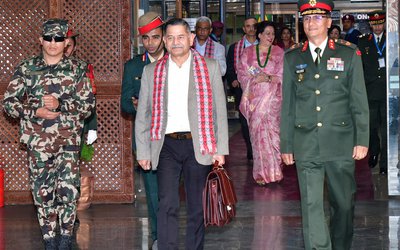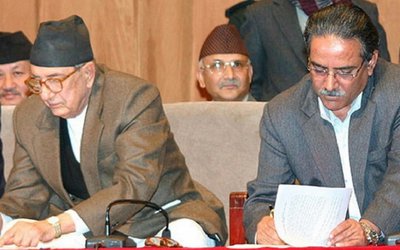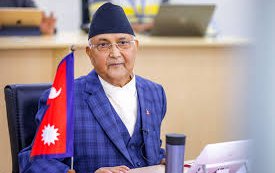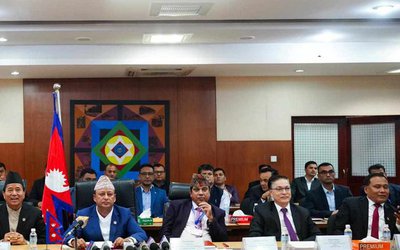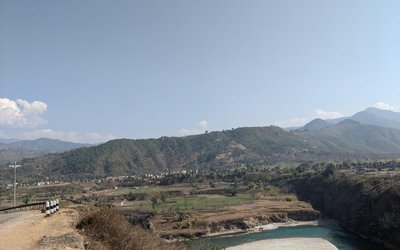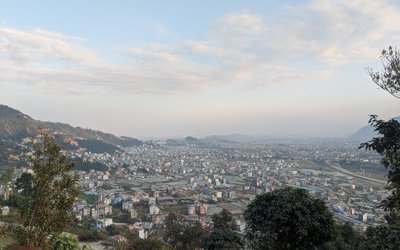
Be it in hard or easy times, the United Kingdom has remained a well wisher and good supporter of Nepal. As Nepal and United Kingdom are celebrating 200 years of establishment of their bilateral relations, the UK has come up with a new package to respond to the needs of earthquake survivors to put through the cold winter.
The approaching winter is of a particular concern in Nepal, a mountainous country. The UN estimates that over 81,000 families require support to keep warm as they live above 1,500m and do not have permanent housing. Blankets, clothes and basic insulation for temporary shelters are urgently needed. DFID is doing its best to ensure the supply of humanitarian winter goods and needs to continue doing so if Nepal is not to see a second round of earthquake related deaths from cold and lack of shelter in the high hills.
Since the earthquakes, relief distribution has been challenged by logistical, access and weather constraints. Though the monsoon season has passed, winter now approaches across Nepal and many remain homeless. The current fuel crisis is compounding the already challenging logistical situation as well as affecting critical activities such as planting and harvests, crucial to helping people recover their livelihoods. Some 528,000 people across the earthquake affected areas have fallen into food insecurity since the earthquake. Some 58,000 remain under tarpaulins in 120 displaced camps across the affected areas, while more than 370,000 families still remain without appropriate temporary shelter.
The UK’s Department for International Development (DFID) reacted swiftly to the 2015 earthquakes in Nepal by allocating a package totalling £70m. The first phase of support was immediate, responding to critical life-saving needs across the 14 most affected districts. Between April and September, £33m was committed to immediate life-saving humanitarian assistance and the delivery of urgent humanitarian supplies. This has included support to remote access logistics ranging from trail repair and use of porters, mules, yaks and tractors to helicopters. £10m was also committed to delivering critical health support, such as immunisation for children, women enabling safe childbirth delivery and rebuilding of damaged health facilities.
According to a press release issued by British Embassy, UK support has so far provided over 200,000 people severely affected by the earthquake with essential shelter; improved water and sanitation support to over 50,000 people; 27,000 people with non-food items and 25,000 people with cash transfers. "We have also supported specific vulnerable groups through our response, particularly 10,000 women and girls with female friendly safe spaces and suitable relief items specific to their needs and over 2,000 injured and vulnerable people with rehabilitation or other medical treatment."
UK has also supported activities that ensure lifesaving humanitarian relief reaches communities inaccessible by road or trails, including the delivery of over 1,000 metric tonnes of items such as medicines and emergency communications equipment, as well as funding over 1,400 flying hours that have ensured humanitarian organisations could deliver lifesaving support to vulnerable and remote communities.
DFID Nepal continues to be a strong supporter of the humanitarian effort in Nepal and announces its second phase of humanitarian assistance. £10m has now been allocated to partners to continue providing critical humanitarian support to vulnerable populations across the districts. This funding will support over 200,000 people receive winterised items, such as urgently needed blankets, mattresses and winter clothes, as well as ensuring critical logistical operations continue to reach highly remote and road-inaccessible locations as winter approaches.
The UK is also supporting early recovery activities that will ensure effective transition from relief to reconstruction, including the removal of debris from at least 1,300 building sites and the demolition/clearance of 100 public buildings, enabling communities to begin rebuilding.
DFID is also supporting activities in 57 displacement camps across 7 earthquake-affected districts, including coordination and urgently needed site improvements such as sanitation, health and protection measures. Over 51,000 people will benefit from these increased camp services, with at least 8,000 internally displaced people receiving bespoke psychosocial support. DFID Nepal stands ready to support the reconstruction phase of the Earthquake and is deeply concerned over the delays of the establishment of the National Authority for Reconstruction – the key institution to accelerate reconstruction and help Nepal build back better.
FAO
Helping Farmers
Six months after the Nepal Earthquake, Food and Agriculture Organization of the United Nations (FAO) continues to support building the resilience of affected farmers.
FAO has continued its support to the government-led efforts to address food security and livelihood needs in the six districts most affected by the earthquakes: Sindhupalchowk, Nuwakot, Dhading, Gorkha, Rasuwa and Dolakha.
Six months after the earthquakes, vulnerable farmers in the worst-affected districts still need agricultural inputs to continue the rehabilitation and reconstruction process and revive the agricultural sector.
FAO has already completed an emergency distribution of 42,000 5kg bags of rice seed in advance of the monsoon planting season. It has also distributed 30,000 durable grain and seed storage bags, with 40,000 more to follow, and nearly 20,000 25kg bags of high-nutrition animal feed. The vegetable seed packet distribution recently completed reached 50,000 households.
“Since the vast majority of rural families are dependent on agriculture for livelihoods, it is FAO’s priority to provide the farmers with the necessary support to revive their crop and livestock production,” said Dr Somsak Pipoppinyo, FAO Representative in Nepal. Dr Somsak extended gratitude to the donors, the government and nongovernmental agencies and the civil society for their generous support to the affected farmers.
In the next few months, FAO will continue distributing farming inputs, grain and seed storage bags and mineral blocks for surviving livestock. Through 240 women’s group, FAO will also distribute plastic sheets for the construction of tunnels to support winter vegetable production to 6 000 households. Twelve community-managed irrigation schemes have been identified and assessed for the provision of support to repair damaged reservoirs and channels.
Food production is still under significant pressure due to the on-going border blockade in the southern part of the country that hinders the import of seeds, fertilizers and other agricultural inputs. FAO is working with government partners to resolve these issues by identifying alternative assistance to support vulnerable populations.
Achieving food security for all is at the heart of FAO's efforts – to ensure people have regular access to sufficient high-quality food to lead active, healthy lives. Our three main goals are: the eradication of hunger, food insecurity and malnutrition; the elimination of poverty and the driving forward of economic and social progress for all; and, the sustainable management and utilization of natural resources, including land, water, air, climate and genetic resources for the benefit of present and future generations.
World Vision International In Earthquake Response
Since the devastating 7.8 magnitude earthquake stuck Nepal back in late April, followed by a second powerful earthquake two weeks later, World Vision has reached over 229,000 beneficiaries, providing immediate relief in 7 of the most affected districts. During the initial phase of the response, those most affected received both food and non-food items. Communities also benefitted from the temporary learning centres (TLC) and child friendly spaces (CFS) established, and from the water, sanitation & hygiene (WASH) programmes and cash-for-work schemes introduced.
World Vision International Nepal Earthquake Response (NER) has so far distributed food and non-food items such as tarpaulins, Corrugated Galvanised Iron (CGI) sheets, sleeping mats, tents, kitchen kits, blankets, shelter tool kits, hygiene kits, mosquito nets to 43,958 households in the hardly hit districts (Sindhupalchowk, Sindhuli, Lamjung, Lalitpur, Bhaktapur, Kathmandu and Gorkha). This support still continues to reach the doorstep of beneficiaries who need it the most.
According to a press release, key to World Vision’s work is its focus on child care and child protection. Thus far more than 8,214 children have benefitted from the 54 TLCs constructed in Gorkha, Sindhupalchowk, Sindhuli and Bhaktapur, and from the CFSs that were immediately erected to provide a safe environment for children to play, learn and recover from this highly stressful event.
To ensure the availability of safe drinking water and hygiene, more than 700 households now benefitted from renovated water systems, as well as the distribution of the aqua tabs, jerry cans and water purifier bags. The household toilets as well as temporary toilets have also been constructed in World Vision’s response area to minimize the probable occurrence of diseases in the aftermath of a disaster. As a part of Cash-for-Work program, World Vision has distributed more than 1 million US dollars to 13,198 families.
World Vision in Nepal is entering its Recovery Phase in November 2015, and it is looking forward to scale up operations to help people of Nepal build back better. For the Recovery Phase, World Vision will support communities to build resilience and restore safety for earthquake affected children and their communities. Alongside communities and other partners World Vision will meet emergency needs, restore services to a higher standard, and empower people with skills and opportunities to sustain themselves. World Vision will prioritize the most vulnerable, fostering social inclusion and gender equity in community interactions for long term change. World Vision’s programs will seek to increase a community’s ability to adapt to change and absorb future shocks.
“I am amazed by the resilience and recovery of Nepalese families. They have worked so hard over the last 6 months to meet their basic needs alongside our support. We are really happy to walk alongside families in the recovery phase as they come back to some sort of normal life, sending their children back to school, beginning to rebuild their houses and starting to think through economic opportunities. I am excited to start to think about the future with earthquake affected communities, where children can grow happy and healthy with stronger schools, health behavour and facilities and real economic opportunity.” says Jennifer MacCann, Nepal Earthquake Response Director.
US Increases Support To Reconstruction
The U.S. Government, through the U.S. Agency for International Development (USAID), has announced three initiatives to support the Government of Nepal’s model of owner-driven housing reconstruction following the April 25, 2015 earthquake. Building on previous investments, USAID programs will train an estimated 13,500 local construction professionals and educate more than 285,000 affected homeowners on building earthquake-resistant homes over the next five years.
According to a press release issued by Public Affairs Section Embassy of the United States, Baliyo Ghar (Strong House) is a five-year, $8 million project that will train local masons, carpenters, engineers, and affected homeowners.
Baliyo Ghar will also support the establishment of a National Reconstruction Technology Center and three training centers at the district and local levels in Dolakha, Dhading, and Nuwakot districts. Baliyo Ghar will be implemented by the National Society for Earthquake Technology (NSET) in cooperation with the Ministry of Urban Development, Ministry of Federal Affairs and Local Development, Council for Technical Education and Vocational Training, and National Planning Commission.
USAID will also expand its ongoing resilience project, Sabal, to invest $2.7 million in training local masons in Sindhupalchok and Kavrepalanchok districts. In addition, USAID has made a $9.6 million contribution to the World Bank Nepal Earthquake Reconstruction Multi-Donor Trust Fund. This contribution will directly support the Government-led beneficiary survey in the 14 most-affected districts, as well as the provision of housing reconstruction cash grants to affected homeowners.
“This week, as Nepal marks six months since the April 25 earthquake, we are pleased to announce our new and expanded initiatives and pledge that we will continue to help rebuild a safer and stronger Nepal,” shared U.S. Ambassador Alaina B. Teplitz. “These new projects and expansions of existing programs are valued at more than $20 million. They are part of the $130 million committed by the U.S. government in response to the earthquake and demonstrate our continued commitment to Nepal.”
Fuel Shortage Affects Humanitarian Supplies
United Nations agencies have said that the onset of winter in Nepal is projected to have an adverse impact on earthquake-affected communities living in high-altitude isolated areas.
A press release issued by the UN Humanitarian Coordinator in Nepal Jamie Mcgoldrick on behalf of the Humanitarian Community said that the humanitarian organizations in Nepal are facing a race against time to ensure delivery of urgently required supplies such as food and shelter materials to these high altitude areas that will soon be cut off with the onset of winter.
“Only a small time window remains before the available land access trails become closed in the coming weeks. Due to limited ability to conduct deliveries by road and air during the recent monsoon season, a backlog of 1,200 MT of shelter and non-food item supplies is awaiting delivery to earthquake-affected population. Eighty per cent of the supplies are warehoused in the districts, but acute shortages in fuel supplies continue to impede planned deliveries to affected villages and trailheads for onward transportation using mules and porters,” said a press release.
"It is of critical importance to deliver supplies to the trailheads by end of October as the passes in the Himalayas will be at increased risk of being blocked by snowfall."
The humanitarian community is implementing contingencies to address the fuel shortages and to increase its capacity to deliver the supplies within an ever decreasing window of opportunity.
- PM Oli's Visit To China: Geopolitical Implications
- Nov 19, 2024
- NEA: Kul Man Ghising, A Cool Man
- Oct 28, 2024
- DASHAIN FESTIVAL : Festival of Unity
- Oct 04, 2024
- NEPAL-CANADA Bilateral Meeting
- Oct 04, 2024
- MIDDLE BHOTEKOSHI: Final Stage
- Sep 23, 2024


